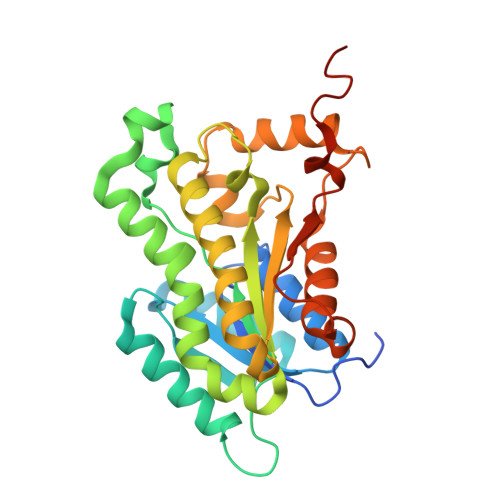Biochemical and structural basis for Moraxella catarrhalis enoyl-acyl carrier protein reductase (FabI) inhibition by triclosan and estradiol.
Katiki, M., Neetu, N., Pratap, S., Kumar, P.(2022) Biochimie 198: 8-22
- PubMed: 35276316
- DOI: https://doi.org/10.1016/j.biochi.2022.02.008
- Primary Citation of Related Structures:
7F44, 7FC8, 7FCM - PubMed Abstract:
The enoyl-acyl carrier protein reductase (ENR) is an established drug target and catalyzes the last reduction step of the fatty acid elongation cycle. Here, we report the crystal structures of FabI from Moraxella catarrhalis (McFabI) in the apo form, binary complex with NAD+ and ternary complex with NAD + -triclosan (TCL) determined at 2.36, 2.12 and 2.22 Å resolutions, respectively. The comparative study of these three structures revealed three different conformational states for the substrate-binding loop (SBL), including an unstructured intermediate, a structured intermediate and a closed conformation in the apo, binary and ternary complex forms, respectively; indicating the flexibility of SBL during the ligand binding. Virtual screening has suggested that estradiol cypionate may be a potential inhibitor of McFabI. Subsequently, estradiol (EST), the natural form of estradiol cypionate, was assessed for its FabI-binding and -inhibition properties. In vitro studies demonstrated that TCL and EST bind to McFabI with high affinity (K D = 0.038 ± 0.004 and 5 ± 0.06 μM respectively) and inhibit its activity (K i = 62.93 ± 3.95 nM and 25.97 ± 1.93 μM respectively) and suppress the growth of M. catarrhalis. These findings reveal that TCL and EST inhibit the McFabI activity and thereby affect cell growth. This study suggests that estradiol may be exploited as a novel scaffold for the designing and development of more potential FabI inhibitors.
Organizational Affiliation:
Department of Biotechnology, Indian Institute of Technology Roorkee, Roorkee, Uttarakhand, 247667, India.

















